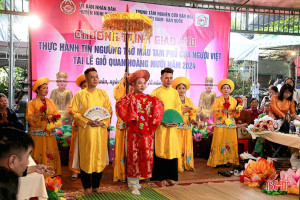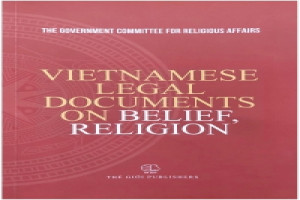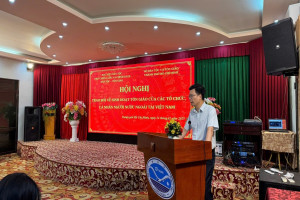
Documents show that Hòa Hảo Buddhism first appeared when World War II was about to start. Huỳnh Phú Sổ conducted a ceremony for the founding of Hòa Hảo Buddhism on 4 July 1939.
The number of Hòa Hảo believers are few and mainly come from the area surrounding Hòa Hảo Village in An Giang province in the deep South of Vietnam. In 1940, the Southern Uprising broke out and was defeated. French reprisals overwhelmed the South. Many people found consolation and salvation in Hòa Hảo Buddhism. By late 1940, the followers numbered some hundreds of thousands.
Founder Huỳnh Phú Sổ established management boards for Hòa Hảo Buddhism at all levels in 1945. However, because of historical circumstances, the Contemporary Central Representative Board of Hòa Hảo Buddhism was not formally established until 1963 and recognized by the Sài Gòn regime on 5 February 1964. The religious power of Hòa Hảo Buddhism overlapped with the activities of the Dân Xã Party and the armed forces of the Hòa Hảo Buddhism.
Hòa Hảo Buddhists worship Buddha but not relics or pictures of Buddha. The symbol of Hòa Hảo Buddhism is a sheet of brown cloth symbolizing “Buddha is the heart, the heart is Buddha” (Phật tại tâm, tâm tức Phật).
In addition to worshipping Buddha and their ancestors, Hòa Hảo Buddhists honor and worship great national heroes and those who have rendered meritorious service to their communities. Hòa Hảo Buddhists do not worship saints or genies without clear origins. Since Hòa Hảo followers are lay people, worship and practice are very simple and conducted mainly at home. In each follower’s house, there are three altars: The altar to Buddha is in the highest place with only a piece of brown cloth; the altar to the ancestors is below the altar to Buddha; and an altar to Heaven is set up in front of the house. More recently, followers have placed a photograph of Huỳnh Phú Sổ just behind the brown cloth on the altar to Buddha.
The Hòa Hảo Buddhist Congregation has organized two congresses: The first term ran from 1999 to 2004, while the second is from 2004 to 2009.
The “2004 Charter” affirms the orientation of the Hòa Hảo Buddhist Congregation as “For Dharma, for the Nation” (Vì Đạo pháp, vì Dân tộc). The central Hòa Hảo doctrine is: “To study Buddhism to improve ourselves; to worship Buddha at home as lay-followers"; to teach followers about the Four Debts of Gratitude (to our ancestors and parents; to our country; to the Three Treasures – Buddha, Dharma, and the Buddhist Church; and to our fellow countrymen and mankind); to follow the eight teachings directly passed by the Venerable Prophet Huỳnh Phú Sổ; to help the poor and the misfortunate; to assist our compatriots in their businesses, marriages, funerals, and ceremonial affairs; to be useful to society and mankind.
According to the “2004 Charter", the Hòa Hảo Buddhist Congregation is administered by a two-level system of management committees set up at villages, districts and provinces/cities, at the top of which is the Central Management Council and Representatives at the provincial/city level. The Central Management Council consists of 21 members, with assisting departments such as Administration, Finance, Public Education, Organizing and Personnel, Social-Charity, and Monitoring.
The term of the Central Management Council is five years. The terms of the Provincial Representative and District Management Council resemble those of the Central Management Council.




